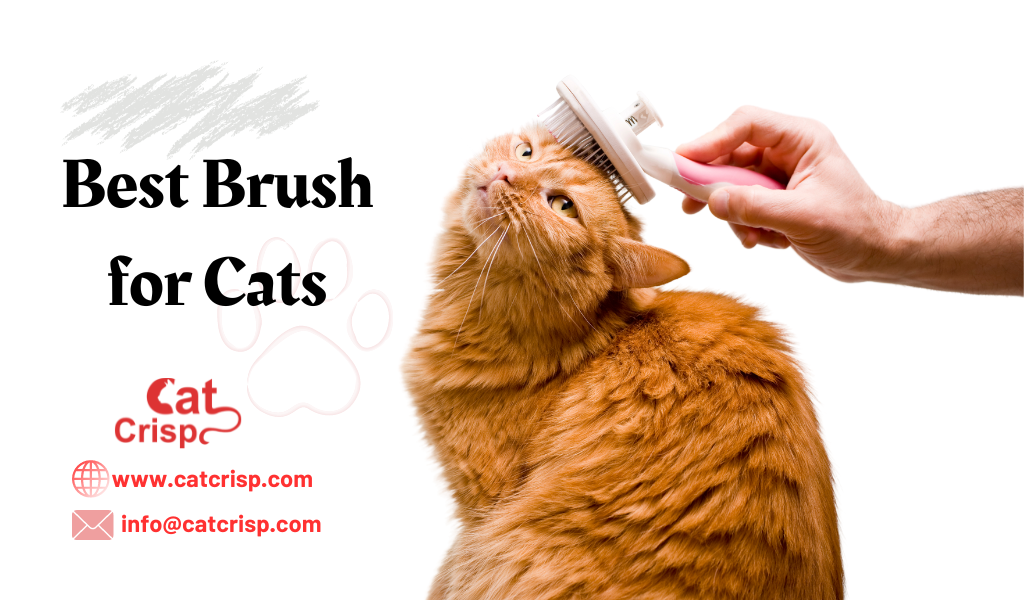Today, I will discuss the best brush for cats for grooming and de-shedding.
Cats are known for their impeccable grooming habits, but even the most fastidious felines can benefit from a good brushing.
Regular grooming helps to reduce shedding, prevents hairballs, and strengthens the bond between you and your pet. However, choosing the right one can be overwhelming with so many brushes on the market.
In this guide, we’ll explore the best types of brushes for cats, how to choose the right one for your pet’s specific needs, and tips for making grooming a pleasant experience for your lovely cat.

Table of Contents
ToggleWhy Regular Grooming is Important
Before diving into the different types of brushes, it’s essential to understand why grooming your cat is so crucial. Here are some key benefits:
Reduces Shedding: Regular brushing removes loose fur, reducing the amount of hair on your furniture, clothes, and floors.
Prevents Hairballs: By removing loose fur, you minimize the amount your cat ingests during self-grooming, thus reducing the risk of hairballs.
Promotes Healthy Skin and Coat: Brushing stimulates blood circulation, distributes natural oils, and removes dirt and debris, contributing to a healthier coat and skin.
Detects Health Issues: Regular grooming allows you to check for signs of parasites, skin conditions, or lumps and bumps that might need veterinary attention.
Strengthens Bond: Grooming provides an opportunity for you to spend quality time with your cat, reinforcing your bond.
Types of Cat Brushes
The type of brush you choose depends on your cat’s coat length and texture. Here’s a breakdown of the most common types of brushes and their benefits:

1. Slicker Brushes
Best for: Long-haired and medium-haired cats
In Slicker brushes, there are fine, short wires close together on a flat surface. They are excellent for removing mats and tangles in long-haired and medium-haired cats. The fine bristles can reach deep into the coat to remove loose fur and dirt without causing discomfort to your pet. When using a slicker brush, be gentle to avoid scratching your cat’s skin.

2. Bristle Brushes
Best for: Short-haired cats
Bristle brushes have soft, densely packed bristles that are ideal for short-haired cats. They help to remove loose fur and distribute natural oils throughout the coat, giving it a healthy shine. Bristle brushes are also great for cats who are sensitive to other types of brushes.

3. Pin Brushes
Best for: Long-haired and medium-haired cats
Pin brushes have widely spaced, rounded-tip pins that are gentle on the skin. They are perfect for removing loose hair and detangling longer coats without causing irritation. Pin brushes can also help to fluff up the fur, giving your cat a more voluminous appearance.

4. Rubber Brushes
Best for: Short-haired cats and sensitive skin
Rubber brushes, such as grooming mitts, are made from soft rubber and are gentle on the skin. They are excellent for short-haired cats and those with sensitive skin. Rubber brushes can also be used during bath time to help lather shampoo and remove loose fur.

5. Deshedding Tools
Best for: All coat types
Deshedding tools, like the popular FURminator, are designed to remove the undercoat and reduce shedding significantly. These tools have a blade-like edge that reaches beneath the topcoat to remove loose hair from the undercoat. They are suitable for all coat types but should be used carefully to avoid removing too much fur.
Choose the Best Brush for Cats
Selecting the right brush for your cat depends on several factors, including coat type, sensitivity, and grooming needs.
Consider Your Cat’s Coat Type: The length and texture of your cat’s coat will determine the type of brush you need. Long-haired cats require brushes that can detangle and remove mats, while short-haired cats benefit from brushes that remove loose fur and distribute oils.
Assess Your Cat’s Sensitivity: Some cats are more sensitive to grooming than others. If your cat has sensitive skin or is skittish about grooming, opt for softer brushes like bristle or rubber brushes.
Evaluate Your Grooming Goals: If your primary goal is to reduce shedding, de-shedding tools may be the best option. For maintaining a healthy coat and preventing tangles, slicker, and pin brushes are more suitable.
Try Different Brushes: It may take some trial and error to find the perfect brush for your cat. Be patient and willing to try different options until you find one that works best for both you and your pet.
Tips for Successful Grooming
Once you’ve selected the right brush, follow these tips to ensure a successful grooming session:
Start Slowly: Introduce the brush to your cat slowly and gently. Allow them to sniff and inspect it before starting to groom.
Use Gentle Strokes: Use gentle, slow strokes to avoid pulling on the fur or causing discomfort.
Reward Your Cat: Offer treats and praise during and after grooming to create a positive association with the activity.
Be Consistent: Regular grooming sessions are more effective than occasional ones. Aim to brush your cat at least once a week, or more frequently if they have a long or thick coat.
Conclusion
Finding the best brush for cats can make a significant difference in their overall health and well-being. By understanding your cat’s coat type, sensitivity, and grooming needs, you can choose the right brush and make grooming a pleasant experience for both you and your feline companion.
Regular grooming not only keeps your cat looking and feeling their best but also strengthens the bond between you, making it a worthwhile investment of your time and effort. Happy grooming!

